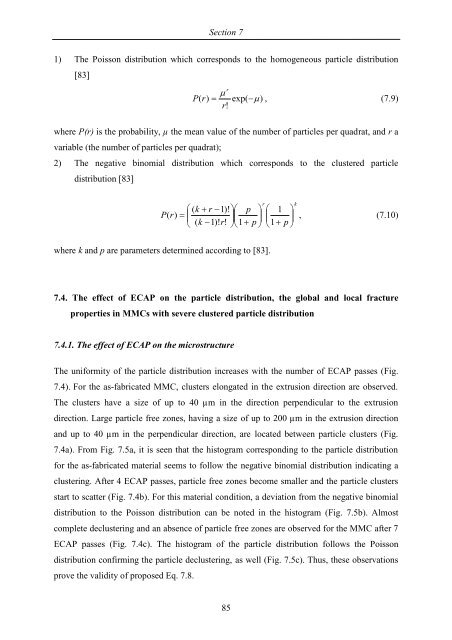dissertation global and local fracture properties of metal matrix ...
dissertation global and local fracture properties of metal matrix ...
dissertation global and local fracture properties of metal matrix ...
You also want an ePaper? Increase the reach of your titles
YUMPU automatically turns print PDFs into web optimized ePapers that Google loves.
Section 7<br />
1) The Poisson distribution which corresponds to the homogeneous particle distribution<br />
[83]<br />
r<br />
µ<br />
P(<br />
r)<br />
= exp( −µ<br />
) , (7.9)<br />
r!<br />
where P(r) is the probability, µ the mean value <strong>of</strong> the number <strong>of</strong> particles per quadrat, <strong>and</strong> r a<br />
variable (the number <strong>of</strong> particles per quadrat);<br />
2) The negative binomial distribution which corresponds to the clustered particle<br />
distribution [83]<br />
85<br />
r<br />
⎛ ( k + r −1)!<br />
⎞⎛<br />
p ⎞ ⎛ 1 ⎞<br />
P( r)<br />
= ⎜ ⎟⎜<br />
⎟ ⎜ ⎟ , (7.10)<br />
⎝ ( k −1)!<br />
r!<br />
⎠⎝1<br />
+ p ⎠ ⎝1<br />
+ p ⎠<br />
where k <strong>and</strong> p are parameters determined according to [83].<br />
7.4. The effect <strong>of</strong> ECAP on the particle distribution, the <strong>global</strong> <strong>and</strong> <strong>local</strong> <strong>fracture</strong><br />
<strong>properties</strong> in MMCs with severe clustered particle distribution<br />
7.4.1. The effect <strong>of</strong> ECAP on the microstructure<br />
The uniformity <strong>of</strong> the particle distribution increases with the number <strong>of</strong> ECAP passes (Fig.<br />
7.4). For the as-fabricated MMC, clusters elongated in the extrusion direction are observed.<br />
The clusters have a size <strong>of</strong> up to 40 µm in the direction perpendicular to the extrusion<br />
direction. Large particle free zones, having a size <strong>of</strong> up to 200 µm in the extrusion direction<br />
<strong>and</strong> up to 40 µm in the perpendicular direction, are located between particle clusters (Fig.<br />
7.4a). From Fig. 7.5a, it is seen that the histogram corresponding to the particle distribution<br />
for the as-fabricated material seems to follow the negative binomial distribution indicating a<br />
clustering. After 4 ECAP passes, particle free zones become smaller <strong>and</strong> the particle clusters<br />
start to scatter (Fig. 7.4b). For this material condition, a deviation from the negative binomial<br />
distribution to the Poisson distribution can be noted in the histogram (Fig. 7.5b). Almost<br />
complete declustering <strong>and</strong> an absence <strong>of</strong> particle free zones are observed for the MMC after 7<br />
ECAP passes (Fig. 7.4c). The histogram <strong>of</strong> the particle distribution follows the Poisson<br />
distribution confirming the particle declustering, as well (Fig. 7.5c). Thus, these observations<br />
prove the validity <strong>of</strong> proposed Eq. 7.8.<br />
k
















